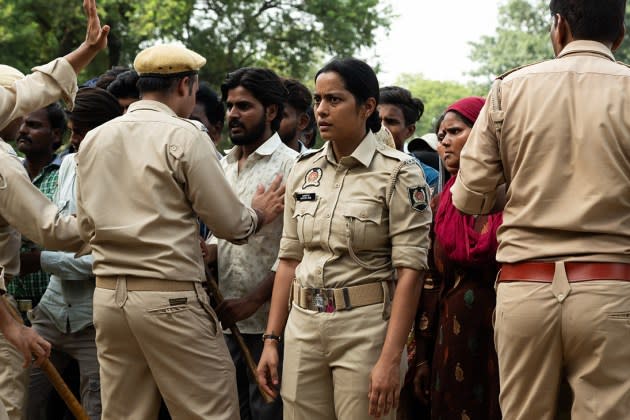‘Santosh’ Review: Two Women Form an Unlikely Alliance in a Gripping Indian Police Procedural

Halfway through Sandhya Suri’s engrossing police procedural Santosh, an older police officer (Sunita Rajwar) reminds a younger constable (Shahana Goswami) that when it comes to criminal cases, everyone — from the victim’s family to the detectives — is playing a role. One party lodges an accusation and the other delivers justice. Whether things are based in truth or reality counts less than one might think. The sentiment, hardly comforting to begin with, adopts a more sinister dimension later in the film, when the two women race against time to find the person who murdered a teenage girl in the Dalit community of a small town in northern India.
A few days after her parents reported her missing, Devika’s body was found in the well. The discovery of the girl (Nandani Tharu), whose swollen body contaminates the community water supply, sets off a storm of bad press for the local authorities. The precinct has already been accused of corruption and discrimination against the Dalit people, who are considered “lower caste” in India. Suri effectively shows the depth of this institutional violence early in Santosh, through scenes in which officers humiliate their constituents with unlawful arrests, extort them through bribes and maintain a culture of hyper-surveillance. In order to save face, the officers decide to investigate the case. They bring in Sharma, a notorious police inspector (Rajwar), and pair her with Santosh (Goswami), a relatively green member of the force.
More from The Hollywood Reporter
George Lucas Says Ideas in the Original "Sort of Got Lost" in Post-Disney 'Star Wars' Films
Box Office: 'Furiosa' Rides to $3.5M in Thursday Previews, 'Garfield' Chases Down $1.9M
Santosh began working as a police officer because of a government program that allows widows of deceased cops to inherit their jobs. Santosh, which premiered at Cannes in Un Certain Regard and was recently acquired by Metrograph for North American distribution, opens with the death of the titular character’s husband, an event that upends Santosh’s life. Unable to return to her own family and rejected by her in-laws, the widow decides to support herself as a police officer. Suri’s film chronicles the kind of moral regression caused by the job. Santosh enters the profession intending, it seems, to cause little harm, but corruption proves too insidious a force.
The pulse of Santosh lies in the relationship between Santosh and Inspector Sharma, a rough-edged detective whose reputation precedes her. The frigidity of their early interactions thaws as they work on Devika’s case. Suri uses these women to portray the polarities of this profession. Santosh, initially, represents a kind of na?veté about India’s justice system, filled with assumptions that the police exist to help those in need. Sharma, on the other hand, has been hardened by experience. Her morals — shaped by years of compromises — bend to the will of circumstance. That we come to understand the layers of both women is a credit to the precision and subtlety of Rajwar and Goswami’s performances.
Goswami, as the anchor of the film, offers a particularly riveting turn, which adds an urgent layer to Suri’s screenplay. Devika’s case becomes a litmus test for Santosh, whose increasing desperation to find the culprit drives her to make choices more characteristic of Sharma. Further detail about her motivations as they relate to her grief might have been helpful, but Goswami plays her character with an appropriate amount of pathos that clarifies the Machiavellian culture of police officers.
After finding the teenager’s phone, Santosh and Sharma focus their attention on locating the young man Devika had been texting right before her death. The facts of the case take a backseat to the adrenaline rush of having a real lead. Suri’s direction, already confident from the opening moments, is deft as the film shifts to match the increasingly frenzied mood. Lennert Hillege’s cinematography casts aside the observational, almost documentary approach for more feverish and claustrophobic camerawork. As Santosh closes in on the suspect, who has absconded for another town, Suri’s film embraces the nail-biting aesthetics — dark and shadowy locales, heart-racing music — of a classic procedural.
This assured sense of direction coupled with controlled performances make Santosh a compelling drama. But it’s Suri’s screenplay that renders the film immersive. The director smartly imbues this low-key, intimate narrative with details that lay out the political reality of India. Instead of unwieldy expository dialogue, Suri relies on conversations between Santosh and Sharma to shed light on the forces — a discriminatory society, a corrupt workplace — that might drive these two women into a kind of reluctant Faustian alliance.
Best of The Hollywood Reporter